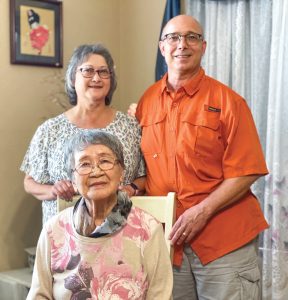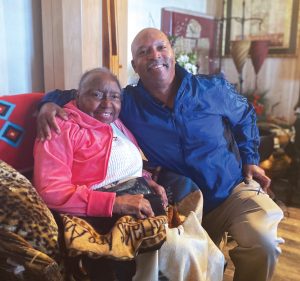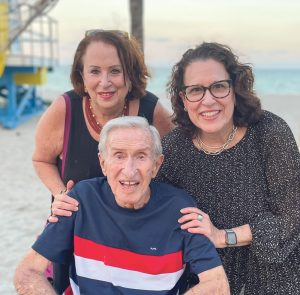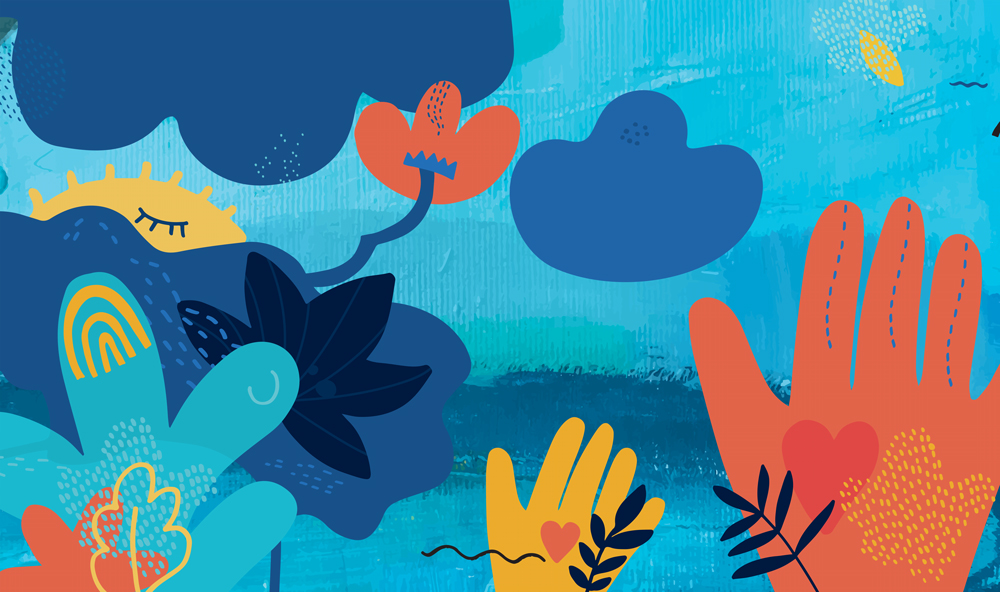Caregiving for an elderly family member is a great responsibility. Truth be told, while it can be incredibly rewarding, it can also be extremely challenging at times. In this issue, we interview SGI-USA members about their caregiving experiences, and include guidance from Ikeda Sensei’s book On Health and Long Life to those undertaking this important role.
Caregiving at Home
Ikeda Sensei: [Founding Soka Gakkai] President [Tsunesaburo] Makiguchi cared for his bedridden elderly mother-in-law. …
He used to carry her on his back to the bathroom and help her bathe. Dr. [Makoto] Michikawa, do you have any personal experience with such caregiving?
Dr. Makoto Michikawa: When I had just begun practicing as a doctor, my grandmother was diagnosed with Alzheimer’s disease. My mother took care of her for about three years at our home.
Ikeda: Her efforts are now being reflected in your research. In caring for others, the important thing is to try not to shoulder it alone. It’s crucial to get advice and help from a variety of people. …
Nichiren praised and encouraged the lay nun Toki (the wife of Toki Jonin), who was caring for her elderly mother-in-law. In a letter to her, Nichiren writes that Toki Jonin said he was grateful that she gave his mother such attentive care and that he would never be able to forget this in any lifetime to come (see “The Bow and Arrow,” The Writings of Nichiren Daishonin, vol. 1, p. 656). These words must have been a great comfort to the lay nun Toki.
Narumi Shosaku: When caregiving at home continues for an extended period, or when there are complications, such as a patient who keeps wandering off, families should consult with professionals. They can also make use of various public or private care services or facilities.
Michikawa: Fortunately, my grandmother did not leave the house and wander around the streets. But in the evening, she would say “I want to go home,” even though she was home. Once, she hid in the closet, and we all had to search the house for her. She would also do things like put her possessions away and then, forgetting she had done so, tell us that she had lost them. I remember once she kept insisting that some weeds in the yard were delicious vegetables and telling my mother that she wanted to eat them. …
At first she tried telling my grandmother that they were just weeds and she couldn’t eat them, but since my grandmother remained unconvinced, my mother finally boiled the weeds and allowed her to taste them. Of course, they were bitter and tough and she didn’t want to eat them, and from then on she stopped insisting that they were delicious vegetables.
Ikeda: Gaining a person’s understanding is better than just telling them no, and winning their consent is better than pleading with them. When we make such efforts for people suffering from dementia, they feel that we care about them and understand them, even though they might not necessarily show it. It gives them comfort and reassurance.
A Balanced Diet
Ikeda: Let’s talk about what people can do to stave off dementia. First, how about diet?
Reiko Inamitsu: A balanced diet is of course crucial. There are several important foods and food groups that were common in the traditional Japanese diet but tend to be lacking in the Japanese diet today—that is, legumes, sesame seeds, seaweed, vegetables, fish, mushrooms and root vegetables.
Narumi: To avoid vascular dementia, it’s important to reduce salt intake. Too much sodium contributes to high blood pressure and hardening of the arteries (arteriosclerosis), which can cause strokes that lead to the onset of dementia.
Ikeda: As was mentioned earlier, some fish oils help prevent the accumulation in the brain of the protein that causes Alzheimer’s, in addition to fighting hardening of the arteries. …
The Benefits of Walking
Ikeda: Exercise is also important in preventing dementia, isn’t it?
Michikawa: Yes, it is. Exercise improves circulation, stimulates the brain, and also has a positive effect on emotional health. …
Inamitsu: I recommend walking for about 30 minutes a day. The best way to walk is to stand tall and take long strides, moving the arms at the same time. Working up a light sweat is ideal.
Ikeda: Early Buddhist practitioners used to engage in a walking practice after meditation, as a form of exercise. An early Buddhist text lists five positive effects of this exercise: 1) physical conditioning, 2) reducing sickness, 3) improving digestion, 4) promoting clear thinking and 5) strengthening the will.
In other words, someone who’s always walking, always on the move, will be in vigorous mental and physical health. In that respect, Soka Gakkai activities are the best health regimen there is. Attending meetings, visiting friends to encourage them, and going out to share Nichiren’s teaching with others—all of these involve activity. And they are all a form of contributive service—for the sake of Buddhism, for the sake of one’s friends and for the sake of society at large.
It could be said that Mr. Makiguchi led the kosen-rufu movement on foot. He walked so much in his effort to share Buddhism with others that his wooden sandals were always worn down to the nubs.
Making Time to Rest
Ikeda: If your days are spent in fulfilling activity, you will enjoy sound sleep. Sleep is very important when it comes to keeping the mind active and alert.
Michikawa: Studies have shown that taking a brief daily nap of less than 30 minutes can also help prevent Alzheimer’s disease.
Ikeda: Until his death at age 92, my friend the American entrepreneur Armand Hammer always took a short nap each day. Sleep is indeed the best medicine. Elderly people in particular need to make an effort to get enough sleep so they don’t become overtired. They should make time to rest in order to keep themselves in the best condition.
Incidentally, are there certain types of people who are less susceptible to dementia?
Michikawa: Some studies show that writers and artists are less likely to experience dementia. It may be because they are constantly using their minds, whether it be reading newspapers and books, writing or engaging in the creative processes of bringing new paintings or other works of art into being. Such people are constantly expanding their neural networks and strengthening the connections between neurons in the brain, which help prevent Alzheimer’s disease. …
Ikeda: Nichiren writes of the state of life that those who have worked hard for kosen-rufu will experience after death, saying:
Chant Nam-myoho-renge-kyo. Continue your practice without backsliding until the final moment of your life, and when that time comes, behold! When you climb the mountain of perfect enlightenment and gaze around you in all directions, then to your amazement you will see that the entire realm of phenomena is the Land of Tranquil Light. The ground will be of lapis lazuli, and the eight paths will be set apart by golden ropes. Four kinds of flowers will fall from the heavens, and music will resound in the air. All Buddhas and bodhisattvas will be present in complete joy, caressed by the breezes of eternity, happiness, true self, and purity. The time is fast approaching when we too will count ourselves among their number. (“The Fourteen Slanders,” WND-1, 760–61)
When they die, people who have dedicated their lives to the Mystic Law will savor such an eternal state of eternity, happiness, true self and purity. [Second Soka Gakkai President Josei] Toda also used to say, “If you carry out your faith wholeheartedly, life itself will become a great joy and you will without fail experience a state of absolute happiness.”
Let us joyfully surmount all challenges that come our way as we aim for the great summit of victory in our lives and kosen-rufu. There is no more exhilarating life or better health regimen.

by Marty and Kumi Bonner, and Mitsue Humeston
Killeen, Texas
Living Buddhism: Hello! Can you share your experience together?
Marty Bonner: My mother-in-law, Mitsue Humeston, came to Killeen, Texas, in 1963 with her husband and daughter, my wife, Kumi. Her husband died just a few years later, and while raising two daughters by herself, she was a pioneer of kosen-rufu here in Texas!
Kumi Bonner: Marty and I married in 1985 and have lived with my mother for most of our marriage. She had been in good health until nine years ago when she had a stroke. The left side of her body was immobile and she was bedridden. Even though she wanted to do everything by herself, she needed help to do basic things, which frustrated her.
Marty: She wasn’t defeated. She chanted Nam-myoho-renge-kyo and told others about Buddhism throughout her hospitalization, and she was discharged early!
Another challenge came in 2018 when she fell and shattered her femur. After the surgeon explained that she needed surgery, she said, “First do something for me and say these words” and proceeded to tell them about Buddhism. She introduced doctors, nurses and other patients to the Mystic Law.
Mitsue Humeston: Due to a broken femur, I could only lift my feet 1 inch off the ground. But I still walked around to shakubuku.
How have you stayed motivated throughout this time?
Kumi:I chant that whatever I’m going through now, I can use it as fuel to change my karma seven generations in the past and in the future (see “On Offerings for Deceased Ancestors,” The Writings of Nichiren Daishonin, vol. 1, p. 820). My mother has four great grandchildren, and four generations are all practicing Buddhism.
Marty:In caring for my mother-in-law, whom I call Mom, I’ve learned to be patient and try to put myself in her shoes. She lost her husband over 50 years ago and has been a strong, independent woman, so it may be challenging for her to have us watch out for her to make sure she doesn’t get hurt.
I think, What would Ikeda Sensei do? He would take care of her because she is a Buddha. I make breakfast every morning and eat it together with her before work and come home for lunch. I listen to her and create nice memories and view caregiving as something that we are in together.
Kumi:One guidance I keep in mind from Sensei is when he said: “Please live with hope throughout your life. Right until the very end of your lives, I hope that you will not only cherish but also realize many great hopes and dreams and inspire others to do the same. …
“There are no deadlocks when you have faith” (My Dear Friends in America, p. 353).
Marty: Using the strategy of the Lotus Sutra has been the key to overcoming each obstacle along the way to ensuring a harmonious family and that Mom can fully and safely enjoy her life.
Mitsue: I appreciate everyone’s support and want to do more and more for kosen-rufu until I take my last breath.

by Tony Coleman
Los Angeles
Living Buddhism: Hello, Tony! I hear that together with your sisters, you care for your mother.
Tony Coleman: I care for my mother, Georgia, together with my sisters, Charna and Sherie. Mom is 86 and has zero mobility.
After work, I rush to her house. I measure her blood sugar, take her to the bathroom, make dinner and do gongyo. In the morning, I go to her home, give her a kiss, do laundry and make breakfast.
Even though she can’t freely move on her own, Mom is full of life force. She has been an SGI member for more than 45 years and loves reading the publications. She asks me to read the World Tribune and Living Buddhism to her. She also has the names of her grandchildren on her Buddhist altar and chants Nam-myoho-renge-kyo every day for them to become capable people for kosen-rufu.
Your mother has such a seeking mind! How would you encourage members struggling to care for elderly family members?
Tony: Patience is the key. There are times when my mother can be difficult. She wants to eat things or do activities that are not healthy and can cause an accident, so we have to stop her. She doesn’t always like when we do that even though we are looking out for her well-being. This can get me frustrated. But when I chant to be patient with her, I remember how much she did raising four children by herself, while working as a school teacher.
When I chant, I think about all of the people my mother has supported throughout her life. I know that she deserves to live her golden years with complete happiness and peace of mind. As much as possible, I take her out in her wheelchair and walk around the neighborhood, updating her about how the neighbors are doing.
I like to keep in mind these words from Ikeda Sensei: “What is the purpose of faith? It is so that each of us can become truly happy and enable others to become happy. Faith is the driving force that lets us apply what we gain from our studies to truly serving people” (Faith Into Action, p. 109).
I’m determined to appreciate each day I can spend with my mother.

by Fern Goldsmith and Ellen Soto
Miami
Living Buddhism: Hi Fern and Ellen! How has it been caring for your father, Irving?
Ellen Soto: Our dad, Irving, moved in with Fern seven years ago when he was 88 years old, following an abusive relationship leading him to attempt to take his own life. During his stay in the hospital, he decided to turn his life around and joined the SGI-USA!
Fern Goldsmith: I was so happy to care for my father. Most of his family died young, so as a little girl, I feared losing him. Although I’ve taken on possibly the most challenging role, I’m so happy I can live with my father, who recently turned 95.
That’s wonderful! What would you say are the keys to caregiving for your father?
Fern: It’s not easy to take care of an aging parent, but I remind myself that that this could possibly be my last day with him.
Things have changed over the past seven years. At first, he was independent, but he’s gradually needed more of my help. Each night, as I give him eye drops, sleeping medication, put him to bed and kiss him goodnight, I say something to him so that if he doesn’t wake up, he will know how much I loved him.
I also have to keep the party going. I plan activities for him, so he can have experiences and meet people.
Ellen: The reality of caregiving is hard, but we both chant Nam-myoho-renge-kyo for his happiness and for him to live as long as possible. I often think of when Nichiren Daishonin said: “If you live even one day longer, you can accumulate that much more benefit. How truly precious your life is!” (“On Prolonging One’s Life Span,” The Writings of Nichiren Daishonin, vol. 1, p. 955)
Fern: We had a wonderful experience on his 95th birthday. He was reluctant to go out but I pushed him to get a haircut and come out to dinner with family and friends. When we started singing happy birthday, everyone in the restaurant joined in, and Dad broke into the biggest smile I had seen seen since before my mom passed away 17 years ago. He resisted each step of the way, but it was worth it!
There are days when he doesn’t want to do anything, and I feel like, What’s the point? But Dad has taught me how to repay my debt of gratitude, how beautiful life is and how to get to know myself more deeply. I chant every morning for his happiness, because I know that the life condition he’s in when he departs will determine the condition in his next life. We both deeply love him and push him each day to be happy and fulfilled.
You are reading {{ meterCount }} of {{ meterMax }} free premium articles

